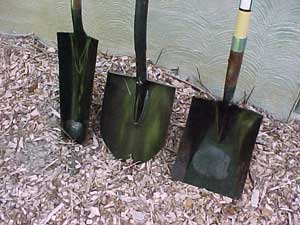 |
| ©: Jeff Ball |
| Transplant shovel, Digging shovel, and Transfer shovel |
Design
The shovel can be long handled or short handled. Long handled shovels almost always have a straight piece of wood or other material for a handle, though some European models have a “T” at the top of the handle for a better grip. The short handle can have either a T shaped end or more commonly what is called a D-Grip end.
It can have a rounded blade or a round blade with a point on it. The back of the blade usually is bent over to give your foot a resting place when helping the shovel move down into the soil; the bend is best when it is bent towards the back of the shovel blade.
Durability
Most shovels will have blades that are either “stamped” or “forged” steel. Forged is better than stamped. Some shovel ads will talk about “tempered” and that is better than those with no tempering. If they talk about “gauge” in the advertisement, the lower number 14 is better than the higher number 16. The better shovels have longer sockets where the handle is attached to the blade. Stainless steel looks nice and resists rust, but in the end is just a fancy shovel that is very expensive.
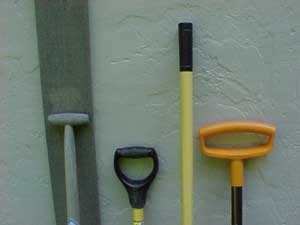 |
| © Jeff Ball |
| Four Handle Designs |
Handle
Shovels come with either a wooden (ash or hickory) handle or a fiberglass handle. Some handles are thicker than others. The wood is heavier but has a nice “feel” to some folks. The fiberglass is lighter and definitely stronger than the wood but doesn’t look as nice to some folks. Whether you prefer a wood or fiberglass shovel, both can last for years if cared for properly it really comes down to comfort and weight.
Comfort and Technique
Most folks will start off with a long handled shovel. It gives you better leverage as you dig and is definitely more comfortable when you are moving a pile of stuff from here to there. Experts advise whenever using a shovel to move something heavy like dirt or sand, the long handled shovel is best for the task. They recommend shifting sides so you vary the effect of repetitive motion which leads to muscle aches and pulls.
Safety Tip
When lifting soil or other heavy material it is very important to keep you back straight and bend you knees as you lift; thereby doing the work with you leg muscles and sparing your back.
The short handled shovels tend to have special jobs such as digging in spaces where there is little extra room. Some yardeners like the feel of the “D” handle on the short handled shovels. It is a matter of personal preference.
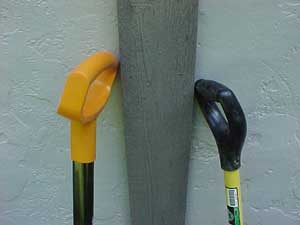 |
| © Jeff Ball |
| Look For Ergonomic Handles Note the handle is on an angle |
There are an increasing number of shovels coming on to the market with what are called “ergonomic” handle designs. There is good evidence that these features have value and should be considered.
Maintaining Shovels and Spades
Maintenance
A good shovel deserves some maintenance to preserve its value over a long period of time. The wooden handle can be oiled with linseed oil (used to care for baseball mitts) and should not be left out in the rain; ever.
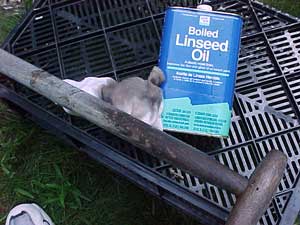 |
| ©: Jeff Ball |
| Linseed Oil Protects Wood Handles |
The blade should be cleaned off when dirt accumulates. Some yardeners keep an old pail filled with sand and about a quart of used automobile oil. As they come into the house, after using the shovel, they dip the blade into the sand a few times to clean it off and give it a thin coat of oil to protect it from rust.
The serious gardener will sharpen the edge of the shovel each spring with a coarse file; a sharp shovel takes less human energy to break down into the soil. Yardener's are certainly allowed to perform this valuable task as well (grin). See examples in the Garden Tool Sharpening Tools
Difference Between Spade and Shovel
It’s easy to mix up a spade and a shovel, they look similar at first glance. But once you know what each one does best, you’ll never grab the wrong tool again. Think of it like this: a spade cuts and shapes, while a shovel scoops and moves. Both earn their place in your shed, but for very different reasons.
Here’s a quick side-by-side look to help you tell them apart:
| Feature | Spade | Shovel |
|---|---|---|
| Primary purpose | Cutting, edging, digging precise holes | Scooping, lifting, and moving loose materials |
| Blade shape & edge | Flat or slightly angled, with a straight edge | Curved or scooped blade, edges bent up to hold material |
| Typical handle | Often shorter, straight or D-grip, for control | Usually longer for leverage, may angle for ergonomic use |
| Best for | Compact soil, edging, roots, clean cuts | Soil, sand, mulch, moving material from one place to another |
| Strength & design | Built for force and penetration | Built for carrying loads efficiently |
| Blade placement | Blade in line with shaft (for pushing down) | Blade often offset or angled to ease scooping action |
FAQ - Still Wondering About Shovels?
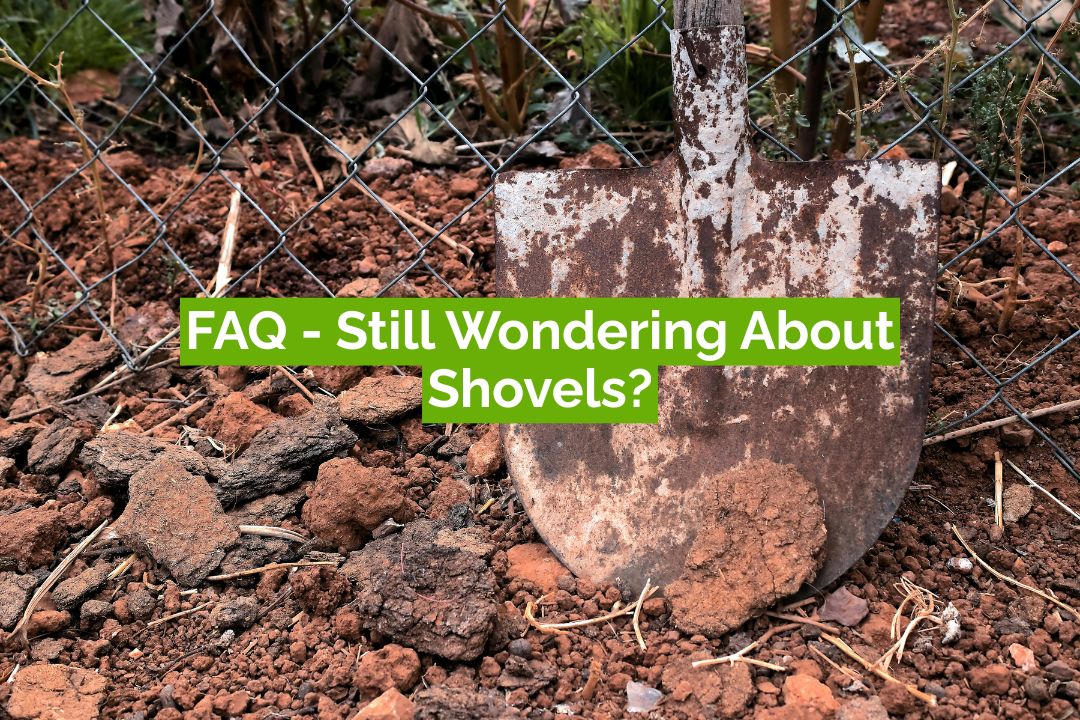
Don’t worry, most yardeners have the same questions before finding their favorite shovel. Here are some quick answers that’ll help you feel confident before buying.
What is a hand shovel called?
A hand shovel is often called a hand trowel or garden spade. It’s a small, handheld tool used for digging tiny holes, planting, or turning soil in tight spots. Some yardeners even call it a belcha, depending on the region. Whatever name you use, it’s the go-to tool for quick planting jobs and pot work.
What does a shovel look like?
A shovel has a broad, curved blade attached to a long handle, usually made of wood, steel, or fiberglass. The blade can be pointed or flat, depending on its job: pointed for digging into soil, flat for scooping or moving material. Some models include a D-shaped grip for comfort and control during heavier work.
What are shovels made of?
Most shovels have a steel blade and either a wooden, fiberglass, or steel handle. A wooden shovel feels natural and solid in your hands but can get heavier over time. A fiberglass shovel is lighter, resists splinters, and handles moisture better. When comparing fiberglass vs wood handle shovels, fiberglass wins for durability, while wood offers a classic grip and balance.
When comparing fiberglass vs wood handle shovels, fiberglass wins for durability, while wood offers a classic grip and balance. If you’re torn between wood vs fiberglass shovels, think about how you’ll use it - go for wood if you like a traditional feel, or fiberglass if you want something that lasts with less upkeep.
How to choose the best shovel for digging holes?
When choosing the best shovel for digging, look for a pointed or round-point blade. A pointed shovel cuts through tough, compact soil, while a round-point works better in softer ground. Pick a long handle for deep holes - it gives you more reach and leverage. Choose steel for strength and fiberglass or wood handles based on comfort and durability.
🎥 This video demonstrates different types of shovels and their uses.
How many kinds of shovel are there?
There are many kinds of shovels, each made for a specific job in the garden or yard. Common ones include digging shovels, scoop shovels, trench shovels, flat shovels, and snow shovels. You’ll also find edging, post-hole, and handheld shovels for smaller tasks. Some even use power shovels or tree-planting shovels for bigger projects - proving there’s a shovel for every kind of work.
What to look for when buying a shovel?
When buying a shovel, think first about what you’ll use it for. A round-point shovel works best for digging, while a square-point makes moving soil or mulch easier. Look for a tempered steel blade for strength and a fiberglass handle if you want something light and weather-resistant. Wood handles feel classic but need more care. Choose a handle length that feels balanced, about chest height - so you can dig comfortably without straining your back.
Are fiberglass or wood shovels better?
Both fiberglass and wood shovels have their strengths. Fiberglass shovels are tougher, more weather-resistant, and great for heavy, frequent use. They absorb shock well and won’t rot or crack in damp conditions. Wood shovels, on the other hand, feel more natural in your hands and are often cheaper. If you love a classic feel, go for wood - if you want something that lasts longer with less care, fiberglass is your best bet.
Which is stronger, wood or fiberglass?
Fiberglass is generally stronger than wood, offering more durability and resistance to warping, cracking, or moisture damage. It holds up better in extreme weather and needs little maintenance. Wood can still last a long time if kept dry and sealed, but it’s more likely to weaken over time. So, for strength and longevity, fiberglass wins - but wood keeps the charm of tradition.
What are the disadvantages of fiberglass?
While fiberglass shovels are strong, they’re not perfect. Fiberglass can become brittle under very heavy pressure and may crack if dropped hard. It’s also more expensive and harder to repair if damaged. In rare cases, fiberglass fibers can irritate your skin during handling. Still, for most yardeners, the low maintenance and durability outweigh these small drawbacks.
Before you go...
If you’ve made it this far, you already know more about shovels than most folks. Choosing the right one isn’t about fancy features, it’s about what feels right in your hands and gets the job done without strain. Whether you go with a wooden handle, fiberglass design, or a sturdy steel blade, a good shovel should make your yard work easier, not harder.
Take your time, test a few if you can, and pick the one that feels like it belongs in your garden shed. Once you find it, you’ll wonder how you ever managed without it.
If you’ve found this guide on choosing a shovel helpful, you might enjoy exploring more tools in our Toolshed of Products. It’s full of simple, no-nonsense tips and gear reviews to make yard work easier - from trowels to pruners and everything in between.

